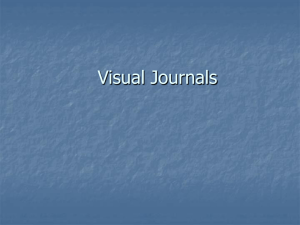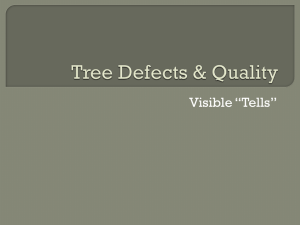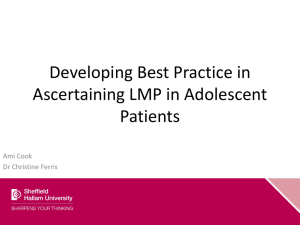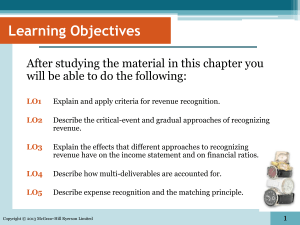Lansawood_Hazardous and Harmful Factors
advertisement
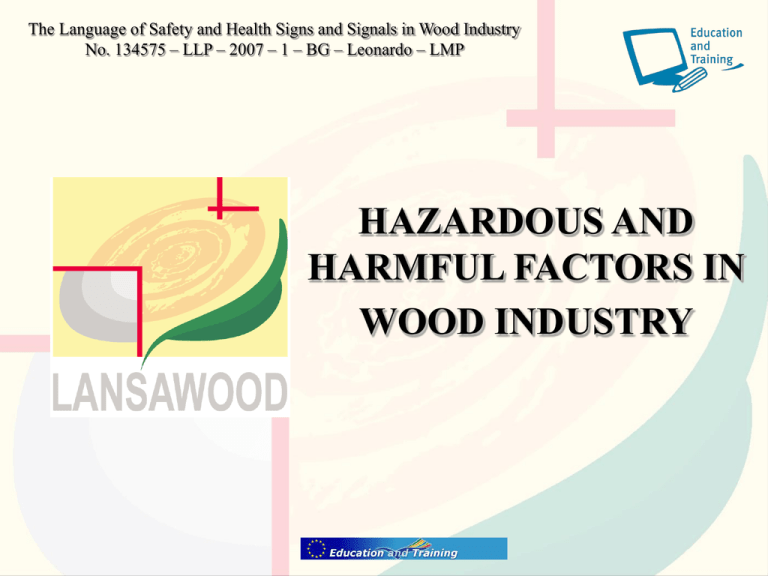
The Language of Safety and Health Signs and Signals in Wood Industry No. 134575 – LLP – 2007 – 1 – BG – Leonardo – LMP HAZARDOUS AND HARMFUL FACTORS IN WOOD INDUSTRY The Language of Safety and Health Signs and Signals in Wood Industry No. 134575 – LLP – 2007 – 1 – BG – Leonardo – LMP Main hazardous and harmful factors in Wood Industry: •Woodworking Machines; •Wood Dust; •Fire and Explosion; •Noise; • Vibrations; • Manual Handling; • Hazardous Chemical Substances; • Slips and Trips The Language of Safety and Health Signs and Signals in Wood Industry No. 134575 – LLP – 2007 – 1 – BG – Leonardo – LMP 1. Woodworking Machines What is woodworking machinery? spindle moulders; circular, crosscut and rip saws; radial arm saws; band saws; jointers; planers; shapers; lathes; sanding machines; boring and mortising machines; routers; tenoning machines, etc. The Language of Safety and Health Signs and Signals in Wood Industry No. 134575 – LLP – 2007 – 1 – BG – Leonardo – LMP What are the risks? •Sharp unguarded parts; •Rotating unguarded parts turning at high revolutions; •The force exerted on a piece of wood by a rotating part causing the machinist to be injured or knocked off balance; •Unguarded moving parts, or moving without warning, or moving unpredictably; •Hand feeding without using a jig or push stick The Language of Safety and Health Signs and Signals in Wood Industry No. 134575 – LLP – 2007 – 1 – BG – Leonardo – LMP What are the dangerous parts? •nip points; •rotating blades; •rotating wheels; •moving parts; •movable (reciprocating) blades; •pressing parts The Language of Safety and Health Signs and Signals in Wood Industry No. 134575 – LLP – 2007 – 1 – BG – Leonardo – LMP Which jobs are affected? Regardless of which job or machine, those carrying out the work must have the skills, knowledge, training and experience, to allow them to work safely in accordance with the manufacturer’s instructions and they must be provided with machines that are properly maintained. The Language of Safety and Health Signs and Signals in Wood Industry No. 134575 – LLP – 2007 – 1 – BG – Leonardo – LMP How should hazardous machines be guarded? •Stationary guards; •Moving, non-interlocking guards; •Interlocking guards The Language of Safety and Health Signs and Signals in Wood Industry No. 134575 – LLP – 2007 – 1 – BG – Leonardo – LMP Stationary guards may be: •fixed guards; •distance guards; •fence guards; • adjustable guards; • riving knives The Language of Safety and Health Signs and Signals in Wood Industry No. 134575 – LLP – 2007 – 1 – BG – Leonardo – LMP Moving, non-interlocking guards may be: •automated guards moved automatically by the machine; •self-adjusting, moveable guards which adjust to accommodate the material. These guards are opened at the beginning of the operation by the passage of the material and return to the safe position when the last of the material passes through the guard. The Language of Safety and Health Signs and Signals in Wood Industry No. 134575 – LLP – 2007 – 1 – BG – Leonardo – LMP Interlocking guards may be: •moving interlocking guards that contain movable parts and whose movement is interconnected with the power or control system of the machine; •interlocking distance guards that do not completely enclose a hazard, but prevent access by their distance from the hazard The Language of Safety and Health Signs and Signals in Wood Industry No. 134575 – LLP – 2007 – 1 – BG – Leonardo – LMP Guard construction Guards can be made from durable material suitable for the purpose and may be: solid sheet metal, metal rod, perforated or mesh material, acrylic or polycarbonate, stainless steel, rubber or timber The Language of Safety and Health Signs and Signals in Wood Industry No. 134575 – LLP – 2007 – 1 – BG – Leonardo – LMP Other forms of safety devices •Trip devices; •Electro-sensitive safety systems; •Pressure sensitive systems The Language of Safety and Health Signs and Signals in Wood Industry No. 134575 – LLP – 2007 – 1 – BG – Leonardo – LMP Basic Safety Rules for People Operating Woodworking Machines •Only authorised people who have been properly trained and assessed as competent, should operate or work at woodworking machines; •Safe operating procedures must be provided and used in respect of each machine; •Appropriate hearing protection, eye shields and dust masks should be worn when required; The Language of Safety and Health Signs and Signals in Wood Industry No. 134575 – LLP – 2007 – 1 – BG – Leonardo – LMP •Machines must be switched OFF when not in use and ISOLATED before any repair, cleaning or maintenance is done; •The machinist’s attention must not be distracted while work is in progress; •Don’t operate machinery if fatigued or otherwise unfit for the task at hand; The Language of Safety and Health Signs and Signals in Wood Industry No. 134575 – LLP – 2007 – 1 – BG – Leonardo – LMP •If mechanical feeding is not available, use push sticks or avoid the need for hands to be near cutters or saw blades; •Wear clothing that will not catch in cutters or other moving parts; •Don’t have long hair free or wear jewellery that might get entangled in the machinery. The Language of Safety and Health Signs and Signals in Wood Industry No. 134575 – LLP – 2007 – 1 – BG – Leonardo – LMP 2. Wood Dust Wood dust consists of tiny particles of wood produced during the processing and handling of wood, particleboards, fibreboards and other composite boards. The Language of Safety and Health Signs and Signals in Wood Industry No. 134575 – LLP – 2007 – 1 – BG – Leonardo – LMP Activities likely to produce high dust levels include: •machining operations; •sanding; •using compressed airlines; •hand assembly of machined/sanded components; •any operations involving composite boards; •the bagging of dust from dust extraction systems; •factory cleaning The Language of Safety and Health Signs and Signals in Wood Industry No. 134575 – LLP – 2007 – 1 – BG – Leonardo – LMP What are the hazards? Health hazards include: •skin disorders; •obstruction in the nose and rhinitis; •asthma; •a rare type of nasal cancer Maximum exposure limit (MEL) - 5 mg/m3 (8-hour time-weighted average). The Language of Safety and Health Signs and Signals in Wood Industry No. 134575 – LLP – 2007 – 1 – BG – Leonardo – LMP Fire/explosion hazard - wood dust fires and explosions; Safety hazard - wood dust on the floor can cause tripping or slipping. Vision can be impaired by airborne chips and dust generated during machining and sanding operations The Language of Safety and Health Signs and Signals in Wood Industry No. 134575 – LLP – 2007 – 1 – BG – Leonardo – LMP Basic Safety Rules •Make sure the personal protective equipment is suitable and kept in good order; •Launder overalls and aprons regularly; •Provide good washing facilities with hot and cold water, soap and towels and encourage a high standard of personal hygiene; The Language of Safety and Health Signs and Signals in Wood Industry No. 134575 – LLP – 2007 – 1 – BG – Leonardo – LMP •Provide vacuum cleaning equipment to remove dust from clothing; •Make sure workers are adequately informed, instructed, trained and supervised; •Check that the design and installation of dust control equipment incorporates explosion precautions; •Keep floors free and clear from wood chips and dust. Pay particular attention to areas around machines and on or near heating units; The Language of Safety and Health Signs and Signals in Wood Industry No. 134575 – LLP – 2007 – 1 – BG – Leonardo – LMP •Clean inside walls, ceilings, ledges and other surfaces of workrooms regularly to prevent dust accumulating; •Do not use compressed airlines or hand brushing as these will create dust clouds and redistribute the dust. The Language of Safety and Health Signs and Signals in Wood Industry No. 134575 – LLP – 2007 – 1 – BG – Leonardo – LMP 3. Fire and Explosion Woodworking facilities are prone to fires and explosions for the following reasons: •Large quantities of fuel in the form of wood and wood products, sawdust, and flammable materials such as paints, oil finishes, adhesives, solvents, etc.; •Ignition sources, such as potentially faulty electrical wiring, cutting and welding operations, sparking tools. There is also the potential for static electrical discharges. The Language of Safety and Health Signs and Signals in Wood Industry No. 134575 – LLP – 2007 – 1 – BG – Leonardo – LMP Basic Safety Rules •Ensure the proper use and storage of flammable materials, such as paints, finishes, adhesives, and solvents; •Segregate tasks particularly prone to fire and explosion hazards, such as spray painting and welding; •Train employees to recognize, avoid, and correct potentially hazardous conditions and behaviors; The Language of Safety and Health Signs and Signals in Wood Industry No. 134575 – LLP – 2007 – 1 – BG – Leonardo – LMP •Train employees so that they are acquainted with the special equipment and aspects of building design related to dealing with fires and explosions; •Control ignition sources; •Never permit blow-down of accumulated dust with compressed air; The Language of Safety and Health Signs and Signals in Wood Industry No. 134575 – LLP – 2007 – 1 – BG – Leonardo – LMP •Provide local exhaust ventilation on all woodworking machines. Dust collection systems must be located outside the building; •Segregate combustible and flammable materials such as timber stock and chemical solvents from each other and from ignition sources; •Ensure that you use equipment with a hazard classification appropriately rated for your work environment. The Language of Safety and Health Signs and Signals in Wood Industry No. 134575 – LLP – 2007 – 1 – BG – Leonardo – LMP What Other Fire Protection Measures Should Be Taken? •Fire-resistant construction and/or fire-resistant materials; •Multiple emergency exits that are well marked and easily accessible; •Emergency alarms and communications systems to promote rapid evacuation and fire-fighting response; •Automatic sprinkler systems designed for a worst-case fire scenario; •Readily accessible, portable fire extinguishers The Language of Safety and Health Signs and Signals in Wood Industry No. 134575 – LLP – 2007 – 1 – BG – Leonardo – LMP 4. Noise What are the hazards? •temporary hearing loss •permanent hearing loss The Language of Safety and Health Signs and Signals in Wood Industry No. 134575 – LLP – 2007 – 1 – BG – Leonardo – LMP Typical noise levels at woodworking machines Machine Typical noise data for machines with no noise reduction measures /dB/ Beam panel saws and sanding machines 97 Boring machines 98 Band re-saws, panel planers and vertical spindle moulders 100 Portable woodworking tools 101 Table saws and multiple ripsaws 102 Thicknessers 104 Edge banders 105 The Language of Safety and Health Signs and Signals in Wood Industry No. 134575 – LLP – 2007 – 1 – BG – Leonardo – LMP Action values •lower action values: daily exposure of 80 dB, and peak sound pressure of 135 dB; •upper action values: daily exposure of 85 dB, and peak sound pressure of 137 dB. Noise exposure limits •daily personal noise exposure of 87 dB •peak sound pressure of 140 dB The Language of Safety and Health Signs and Signals in Wood Industry No. 134575 – LLP – 2007 – 1 – BG – Leonardo – LMP Controlling noise •using the best systems of work; •using the most appropriate machine for the task; •engineering noise control at source; •effective maintenance of equipment; •limiting how long people are exposed to noise The Language of Safety and Health Signs and Signals in Wood Industry No. 134575 – LLP – 2007 – 1 – BG – Leonardo – LMP Personal hearing protection If an employee’s personal noise exposure reaches or exceeds the upper action values then hearing protection is compulsory. The employer must provide it and employees must use it. Hearing protectors should be selected to: •protect against the noise levels in the workplace; •be comfortable; •be suitable for wearing with other personal protective equipment. The Language of Safety and Health Signs and Signals in Wood Industry No. 134575 – LLP – 2007 – 1 – BG – Leonardo – LMP Basic Safety Rules Make employees aware of the need to wear hearing protection whenever they are exposed to noise. Not wearing hearing protection for even a short period of time in a noisy environment will significantly reduce the protection they receive over the working day. The Language of Safety and Health Signs and Signals in Wood Industry No. 134575 – LLP – 2007 – 1 – BG – Leonardo – LMP 5. Vibrations A significant physical hazard in the workplace. It is a disease that develops and spreads slowly through the muscles and circulatory system of the fingers, hands and forearms. Hazards: •"white fingers“; •hand-arm vibration syndrome (HAVS) The Language of Safety and Health Signs and Signals in Wood Industry No. 134575 – LLP – 2007 – 1 – BG – Leonardo – LMP The vibration 'dose' received by a worker over a day depends on: •vibration frequency (the worst range is from 5 to 20 Hertz); •exposure duration; •the grip and push force required to guide the tool or work piece. The Language of Safety and Health Signs and Signals in Wood Industry No. 134575 – LLP – 2007 – 1 – BG – Leonardo – LMP Basic Safety Rules •Maintain machines in proper working order. Unbalanced rotating parts or unsharpened cutting tools can give off excessive vibration; •Arrange work tasks so that vibrating and nonvibrating tools can be used alternately; •Restrict the number of hours a worker uses a vibrating tool during the workday. Allow employees to take 10 to 15 minute breaks from the source of the vibration every hour; The Language of Safety and Health Signs and Signals in Wood Industry No. 134575 – LLP – 2007 – 1 – BG – Leonardo – LMP •Train workers about the hazards of working with vibrating tools. Instruction should include: the sources of vibration exposure, early signs and symptoms of hand-arm vibration syndrome, and work practices for minimizing vibration exposure; •Instruct workers to keep their hands warm and dry, and to not grip a vibrating tool too tightly. Workers should allow the tool or machine to do the work. The Language of Safety and Health Signs and Signals in Wood Industry No. 134575 – LLP – 2007 – 1 – BG – Leonardo – LMP 6. Manual Handling What is manual handling? Manual handling is any transporting or supporting of a load by one or more workers. It includes the following activities: lifting, holding, putting down, pushing, pulling, carrying or moving of a load. Manual handling is also sometimes called manual material handling. The Language of Safety and Health Signs and Signals in Wood Industry No. 134575 – LLP – 2007 – 1 – BG – Leonardo – LMP What are the problems? In woodworking, manual handling causes approximately 30% of the work-related injuries reported each year. What are the causes? •poor workplace or job design; •heavy or awkward loads; •difficulty in gripping; •excessive use of force; •repetition; •twisting and other awkward postures The Language of Safety and Health Signs and Signals in Wood Industry No. 134575 – LLP – 2007 – 1 – BG – Leonardo – LMP What are the possible negative health effects of manual handling? •Cuts, bruises, fractures etc., due to sudden, unexpected events such as accidents; •Damage to the musculoskeletal system of the body (muscles, tendons, bones, joints, blood vessels and nerves) as a consequence of gradual and cumulative wear and tear through repetitive manual handling. The Language of Safety and Health Signs and Signals in Wood Industry No. 134575 – LLP – 2007 – 1 – BG – Leonardo – LMP What is the cost? Costs to the company can come from: loss of production; poor product quality; sickness payments; accident injury claims and higher insurance premiums; high staff turnover and retraining; Costs to the individual are: pain; possible permanent disability; time off work; and loss of earnings The Language of Safety and Health Signs and Signals in Wood Industry No. 134575 – LLP – 2007 – 1 – BG – Leonardo – LMP Prevention measures •Elimination – can manual handling be avoided or restricted?; •Technical measures - automation, mechanisation and the use of lifting and transport equipment; •Organisational measures; •Information and training The Language of Safety and Health Signs and Signals in Wood Industry No. 134575 – LLP – 2007 – 1 – BG – Leonardo – LMP Basic Safety Rules Lifting •Put your feet around the load and your body over it (if this is not feasible, try to keep your body as close possible to the load and in front of it); •Use the muscles of your legs when lifting; •Keep your back straight; •Pull the load as close as possible to your body; •Lift and carry the load with straight arms. The Language of Safety and Health Signs and Signals in Wood Industry No. 134575 – LLP – 2007 – 1 – BG – Leonardo – LMP Pushing and pulling •Pushing and pulling should be done using the body’s own weight: when pushing you should lean forward, when pulling you should lean backward; •You should have enough grip on the floor in order to lean forward/backward; •Avoid twisting, turning and bending the back; •Handle height should be between the shoulder and waist so that you can push/pull in a good, neutral posture; •Handling devices should be well-maintained so that the wheels run smoothly. The Language of Safety and Health Signs and Signals in Wood Industry No. 134575 – LLP – 2007 – 1 – BG – Leonardo – LMP 7. Hazardous Chemical Substances What are the health risks? The main health risks are occupational asthma and dermatitis. Some of the substances used can have very serious effects on the liver, kidneys and the central nervous system. The Language of Safety and Health Signs and Signals in Wood Industry No. 134575 – LLP – 2007 – 1 – BG – Leonardo – LMP What substances used in woodworking can cause disease? •wood dust from hardwood, softwood and wood composites, such as particleboard and medium density fibreboard (MDF); •resins used in the manufacture of compressed products and particleboards; •coatings, such as paints, varnishes, stains and preservatives; •adhesives, such as those used in lamination or furniture assembly; •stripping agents; •solvents The Language of Safety and Health Signs and Signals in Wood Industry No. 134575 – LLP – 2007 – 1 – BG – Leonardo – LMP Basic Safety Rules •Select the most suitable protective device for each work task or exposure. Refer to the producer’s guidance for appropriate choice; •Respirators should only be used by one worker and not be shared; •In regular use, the device should be kept in good condition, cleaned after use, filters changed as appropriate and the device checked for technical or other damage; The Language of Safety and Health Signs and Signals in Wood Industry No. 134575 – LLP – 2007 – 1 – BG – Leonardo – LMP •Make sure equipment for personal use, such as gloves, is carefully selected, worn, maintained and replaced; •Lay down written procedures for regular cleaning, disinfecting, storing, inspection, repairing, discarding and maintaining respirators. The Language of Safety and Health Signs and Signals in Wood Industry No. 134575 – LLP – 2007 – 1 – BG – Leonardo – LMP 8. Slips and Trips •the single most common cause of injuries at work; •occur in almost all kinds of workplace; •There is an increased risk of injury from slips and trips whilst carrying out manual handling activities The Language of Safety and Health Signs and Signals in Wood Industry No. 134575 – LLP – 2007 – 1 – BG – Leonardo – LMP Measures to control slips and trips: •Preventing floor contamination; •Managing spillages and cleaning regimes; •Effective matting systems; •Choice of suitable footwear; •Design of the workplace and work activities; •Maintenance of plant and the work environment; •Specification of appropriate flooring; •Effective training and supervision The Language of Safety and Health Signs and Signals in Wood Industry No. 134575 – LLP – 2007 – 1 – BG – Leonardo – LMP Basic Safety Rules •Every floor and the surface of every traffic route should be constructed so as to be suitable for the specific use; •The floor should have no holes; slopes or be uneven or slippery so as to give rise to risks; •Floors should be provided, where necessary, with effective drainage; The Language of Safety and Health Signs and Signals in Wood Industry No. 134575 – LLP – 2007 – 1 – BG – Leonardo – LMP •Floors and traffic routes should be kept free from obstructions and from any article or substance that may cause a person to slip, trip or fall; •Employees should be trained so that they are acquainted with the appropriate footwear for the specific workplace conditions; •Provide all necessary signs and signboards, e.g. “no running”, “slippery floor”, etc. The Language of Safety and Health Signs and Signals in Wood Industry No. 134575 – LLP – 2007 – 1 – BG – Leonardo – LMP THANK YOU FOR YOUR ATTENTION!

